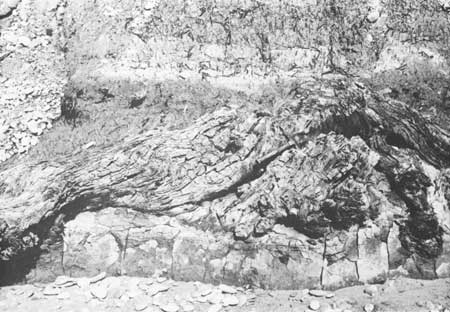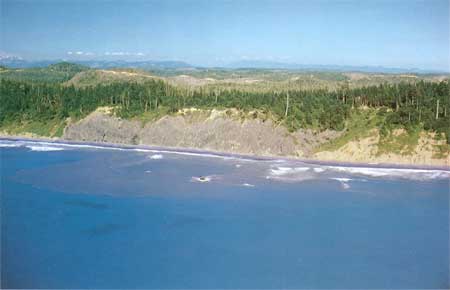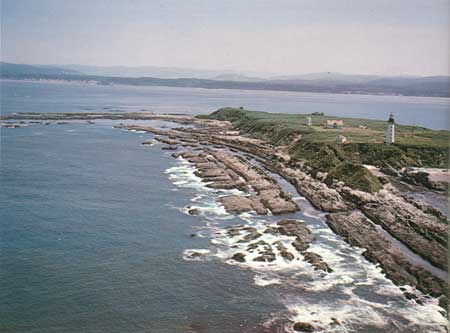
|
Washington Department of Natural Resources Geology and Earth Resources Division Bulletin No. 66 Geology of the Washington Coast between Point Grenville and the Hoh River |
PART II
Geologic Observations and Interpretations Along Segments of the Coast
RAFT RIVER TO WHALE CREEK
NORTHERNMOST OUTCROPS OF THE QUINAULT FORMATION
About one-quarter of a mile north of Raft River jumbled Hoh rocks are poorly exposed for a few hundred feet at the base of the cliff beneath landslide debris of sand and gravel. These Hoh rocks are similar to those seen in the Hogsbacks area and appear to be in fault contact with the younger Quinault Formation, both to the north and south. Structural relations, therefore, suggest that this small outcrop of badly jumbled rocks may well have been injected into the Quinault Formation in much the same way as Hoh rocks are believed to have been emplaced in an area south of Duck Creek. (See Part I, Hoh rock assemblage, Piercement structures).
For a distance of at least three-quarters of a mile northward, massive sandy siltstone of the Quinault Formation is poorly exposed in the bluffs beneath sand and gravel deposits and intermittently in low-tide outcrops. Landslides are common in this area and therefore the Quinault Formation is partially covered by slumped deposits of the overlying younger sand and gravel. Because the massive siltstones of the Quinault Formation are relatively soft and structurally weak, they too have slumped, forming a low-lying hummocky topography. Drunken forests are common in this area and indicate that the land surface was disrupted during the growth of these trees. Although the amount of sand covering the outcrops on the beach varies from time to time, on occasion the Quinault Formation is rather well exposed during low tide at the north end of this series of outcrops. It extends to a point about 1-1/4 miles north of Raft River and represents the northernmost outcrop of the formation known along the coast. Here the rocks are generally massive siltstone, but some display faint bedding that indicates the beds are steeply dipping northward.
OLDER DEPOSITS OF SAND AND GRAVEL
At the northernmost outcrop of the Quinault Formation, steeply dipping deposits of semiconsolidated gray-colored sand and gravel are in abrupt contact with steeply dipping siltstone beds of the Quinault Formation. In this area both the steeply dipping sand and gravel beds and the Quinault Formation are overlain by the same nearly horizontal iron-stained sand and gravel deposits that can be seen in the upper part of most cliffs southward to Point Grenville. In this immediate area therefore, three distinct rock units are exposed: the bedrock Quinault Formation, older tilted sand and gravel beds, and the younger nearly horizontal deposits of sand and gravel (fig. 26; see Part I, Cenozoic deposits). Because both the Quinault Formation and the older of the two sand and gravel deposits are steeply tilted in this area, the folding and possibly faulting that deformed them took place after deposition of the latter, most likely in the Pleistocene Epoch but prior to the deposition of the younger horizontal and unaffected sand and gravel.
From here northward to a place about one-quarter of a mile north of the mouth of Whale Creek, both sand and gravel units are exposed in the cliffs and can be easily distinguished, mainly because the older unit is a dark-gray color at the base of the cliff and appears to dip decidedly in a west-northwest direction, whereas the younger overlying deposits are iron stained and are nearly horizontal (fig. 22).
The contact between these two deposits constitutes the same wave-cut surface that was carved by the sea on bedrock in other areas both to the south and north. However, in this area the bedrock surface was below the level of the wave cutting, and the surface was formed on the older sand and gravel unit that previously had covered the bedrock.
RECENT WARPING OF THE EARTH'S CRUST
Since the deposition of the younger sand and gravel deposits, broad warping has very gently tilted northward all deposits in the Whale Creek area. Therefore, the once horizontal contact (wave-cut surface) between the two deposits of sand and gravel is also gently tilted northward. South of Whale Creek the older deposits extend upward to a height of some 35 feet from the base of the cliffs; but they become less and less of the total height of the cliffs northward until finally about one-quarter of a mile north of Whale Creek the contact between the two sand and gravel units projects beneath the base of the cliffs. From that point northward to the Kalaloch area, the cliffs are composed entirely of the younger of the two sand and gravel deposits.
OLD WOOD REVEALS AGE OF DEPOSITS
From the northern end of the outcrop area of the Quinault Formation to Whale Creek and for some distance beyond, at least one major carbonaceous bed containing branches, stumps, and even small logs can be seen in the younger sand and gravel deposits (fig. 52). This bed is largely compressed vegetation and is known as peat, the beginning stages of coal. Radiometric dating of samples of this material show that it is more than 30,000 years old.

|
| A DISTORTED TREE STUMP, surrounded by deposits of carbonaceous clay and silt, exposed at the base of the cliff about 1 mile north of Whale Creek. Radiometric dating of samples from this stump indicate that it is older than 30,000 years. Hammer in center of photo is about 12 inches in length. (Fig. 52) |

|
| PIERCEMENT STRUCTURE between Cape Elizabeth and Duck Creek. The dark colored cliffs are composed of broken and contorted rocks of the Hoh rock assemblage. These materials are believed to have been squeezed upward into the lighter colored Quinault Formation seen here in the cliffs on each side. (Fig. 53) |

|
| DESTRUCTION ISLAND, once known as "Green Island" by some of the early explorers, has a foundation of steeply dipping sandstone strata of the Hoh rock assemblage. A thickness of some 50 feet of Pleistocene sand and gravel forms the uppermost part of the island. Its nearly flat surface is a western remnant of a broad plain that was formed on outwash deposits and extended westward from the present-day mainland to and beyond Destruction Island during the Pleistocene Epoch. (Fig. 54) |
| <<< Previous | <<< Contents >>> | Next >>> |
state/wa/1973-66/sec2-8.htm
Last Updated: 28-Mar-2006